 MALAYSIA--Part 2
MALAYSIA--Part 2 MALAYSIA--Part 2
MALAYSIA--Part 2
KUALA LUMPUR
Kuala Lumpur is Malaysia's capital and by far its biggest city. In a way, it's like Malaysia's Los Angeles while Penang is its San Francisco (kind of like I suggested Bangkok and Chiang Mai are in Thailand). It's not very old, like LA, having been established only 150 years ago. And, its history is reminiscent of California's: tin was discovered in abundance (tin is mixed with copper to make bronze), and miners from as far away as China came to make their fortune. Other people from India and parts of Southeast Asia were brought in as well to help build up the burgeoning city, and multicultural Kuala Lumpur was born.
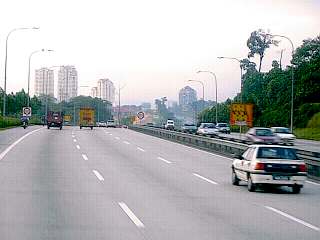 Coming
into Kuala Lumpur from the airport was a complete surprise to me, especially
after travel in Indonesia and Thailand. I'd supposed that Malaysia was somewhat
more modern, from what I'd read, but I wasn't ready for scenes like this. On
the surface, it seemed almost like being in the U.S.! I tried to figure out
what it was that made it seem so familiar, and came up with these thoughts:
1) there are lots of passenger cars, and almost no motorbikes, bicycles, smoky
trucks and other slow vehicles; 2) the roads are wide and well-maintained, and
everyone actually stays in their lane (!); 3) there are clear signs to mark
instructions for drivers, the characters (letters) are the same as in English,
and many of them are even IN English; and 4) there is a lot of suburban development
around the city, with most of it being tract housing (those "ticky-tacky" houses
you see in every suburb, all next to each other and exactly the same).
Coming
into Kuala Lumpur from the airport was a complete surprise to me, especially
after travel in Indonesia and Thailand. I'd supposed that Malaysia was somewhat
more modern, from what I'd read, but I wasn't ready for scenes like this. On
the surface, it seemed almost like being in the U.S.! I tried to figure out
what it was that made it seem so familiar, and came up with these thoughts:
1) there are lots of passenger cars, and almost no motorbikes, bicycles, smoky
trucks and other slow vehicles; 2) the roads are wide and well-maintained, and
everyone actually stays in their lane (!); 3) there are clear signs to mark
instructions for drivers, the characters (letters) are the same as in English,
and many of them are even IN English; and 4) there is a lot of suburban development
around the city, with most of it being tract housing (those "ticky-tacky" houses
you see in every suburb, all next to each other and exactly the same).
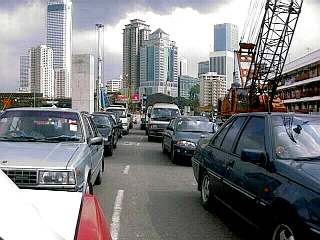 As
you get into town, it feels even more like the U.S. The traffic jams are the
same; the skyscrapers, and cranes standing next to ones still being put up,
add to the sense of being in a modern, developed country. Certainly, this is
the big city, and the countryside isn't nearly as developed, but Kuala Lumpur
feels as modern as any city I've been in.
As
you get into town, it feels even more like the U.S. The traffic jams are the
same; the skyscrapers, and cranes standing next to ones still being put up,
add to the sense of being in a modern, developed country. Certainly, this is
the big city, and the countryside isn't nearly as developed, but Kuala Lumpur
feels as modern as any city I've been in.
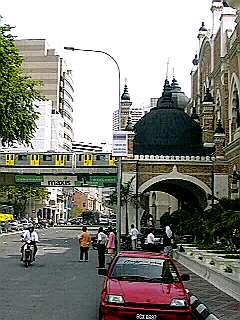 The
new development fits in well with the old buildings from colonial times, which
were wisely built with a Muslim architectural feel rather than purely European,
as in most other colonial capitals I've visited in Southeast Asia. It creates
a nice atmosphere that works well with the cultural context it's in. Here, the
older courthouse (on the right) contrasts with the more modern buildings and
the city's brand new elevated railway.
The
new development fits in well with the old buildings from colonial times, which
were wisely built with a Muslim architectural feel rather than purely European,
as in most other colonial capitals I've visited in Southeast Asia. It creates
a nice atmosphere that works well with the cultural context it's in. Here, the
older courthouse (on the right) contrasts with the more modern buildings and
the city's brand new elevated railway.
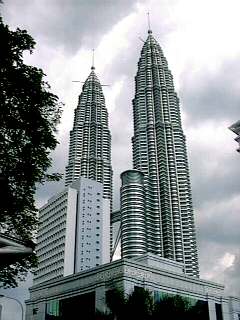 But
clearly the "crowning jewels" of the city are the Petronas Twin Towers, the
tallest buildings in the world. They were built to bring status to Kuala Lumpur
and Malaysia on the world scene, and I have to say they look pretty spectacular...
But
clearly the "crowning jewels" of the city are the Petronas Twin Towers, the
tallest buildings in the world. They were built to bring status to Kuala Lumpur
and Malaysia on the world scene, and I have to say they look pretty spectacular...
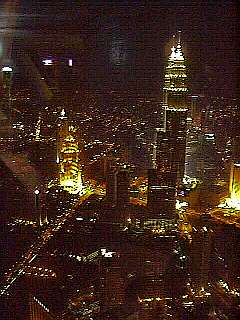 ...especially
at night!
...especially
at night!
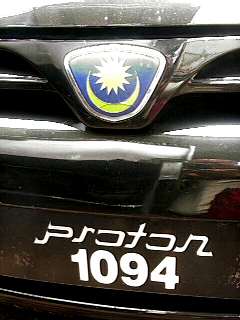 Malaysia
has developed as far as it has much by its own initiative and hard work along
with careful use of international help. Here is an example. Well over half the
cars on the road are Protons, which are made in Malaysia for the domestic market
(I've never seen one anywhere else) at factories run jointly with the Japanese.
The logo is the national symbol that you'd also see on the country's flag. So
why is Malaysia so highly developed compared to other Southeast Asian countries?
Some of the answers may surprise and even offend you. Good! Read
my own guesses.
Malaysia
has developed as far as it has much by its own initiative and hard work along
with careful use of international help. Here is an example. Well over half the
cars on the road are Protons, which are made in Malaysia for the domestic market
(I've never seen one anywhere else) at factories run jointly with the Japanese.
The logo is the national symbol that you'd also see on the country's flag. So
why is Malaysia so highly developed compared to other Southeast Asian countries?
Some of the answers may surprise and even offend you. Good! Read
my own guesses.
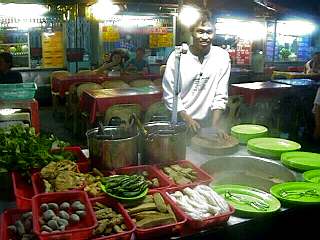 Food
in Kuala Lumpur is TREMENDOUS. In such a diverse society, the choices are
many: great Chinese food of all varieties; delicious Indian foods, including
tandooris and pooris and lassis and...; and traditional Malay food, like curries,
which are sometimes hot but usually not because they have coconut milk bases.
The latter are ALWAYS served with sambals, though, to add for yourself
-- these are SUPER-hot condiments with LOTS of chilies. There are unique cuisines
to Malaysia, too, like "Nonya" food, which is a fantastic Malay/Chinese cross.
You find these foods in restaurants, for sure, but it's more fun (and much
cheaper) to go to the night markets and find them at stands like this.
Food
in Kuala Lumpur is TREMENDOUS. In such a diverse society, the choices are
many: great Chinese food of all varieties; delicious Indian foods, including
tandooris and pooris and lassis and...; and traditional Malay food, like curries,
which are sometimes hot but usually not because they have coconut milk bases.
The latter are ALWAYS served with sambals, though, to add for yourself
-- these are SUPER-hot condiments with LOTS of chilies. There are unique cuisines
to Malaysia, too, like "Nonya" food, which is a fantastic Malay/Chinese cross.
You find these foods in restaurants, for sure, but it's more fun (and much
cheaper) to go to the night markets and find them at stands like this.
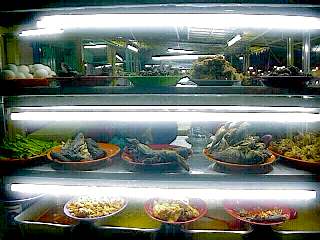 You
can just walk along and look through the glass fronts of the stands, waiting
until you find something that looks really good and pointing at it for the "hawker"
to serve you. Even the government values this way of serving food; when many
hawkers came close to bankruptcy during the economic crisis, the government
subsidized loans for them.
You
can just walk along and look through the glass fronts of the stands, waiting
until you find something that looks really good and pointing at it for the "hawker"
to serve you. Even the government values this way of serving food; when many
hawkers came close to bankruptcy during the economic crisis, the government
subsidized loans for them.
| Sometimes, traveling in other countries makes you look at your own country in a different light. I was very upset last year when the U.S. government dismantled the welfare system without doing much to guarantee that people losing those benefits would get the training and other support they'd need to get "back on their feet." But being here makes me even more frustrated with how our country treats its poor. I've seen many TV ads in Malaysia concerned with encouraging people to help the poor, and providing information to people in need about how to get assistance. It made me think about how there USED to be such ads in the U.S., but now they're rarely if ever seen. Have we lost our compassion for the poor? Do the media and the powers-that-be even acknowledge that poverty exists? Banks here set up special savings accounts for the hard-core poor and make contributions to those accounts. Do U.S. banks do the same? (Just kidding -- of course they don't.) What do we really do, as a MUCH richer country than Malaysia, to help people in poverty get back on their feet? Just asking. |
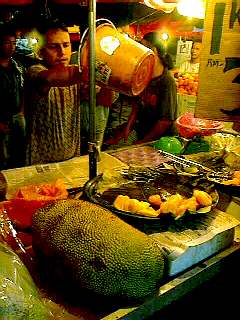 I
passed this stand worried that I'd have to bear the smell of durian fruit (see
the Thailand section for an explanation). But I needn't have worried -- it looks
kind of similar on the outside, because it's big and spiked, but this is jackfruit,
a much more bearable fruit (to me, anyway). You always have to have fruit after
a Malaysian meal, and there are lots and lots to choose from. I'll bet there
are some you've never heard of that you'd really love. You'll have to come here
to see.
I
passed this stand worried that I'd have to bear the smell of durian fruit (see
the Thailand section for an explanation). But I needn't have worried -- it looks
kind of similar on the outside, because it's big and spiked, but this is jackfruit,
a much more bearable fruit (to me, anyway). You always have to have fruit after
a Malaysian meal, and there are lots and lots to choose from. I'll bet there
are some you've never heard of that you'd really love. You'll have to come here
to see.
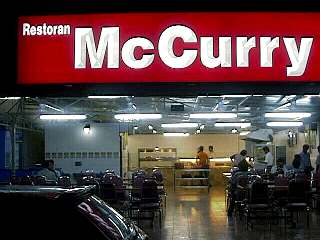 Here's
another example of the paradox of Malaysia's anti-Western attitudes versus the
reality you see in the street. On the other hand, it's more likely just someone's
really funny sense of humor. (Now McDonald's will probably go out and try to
sue them...)
Here's
another example of the paradox of Malaysia's anti-Western attitudes versus the
reality you see in the street. On the other hand, it's more likely just someone's
really funny sense of humor. (Now McDonald's will probably go out and try to
sue them...)
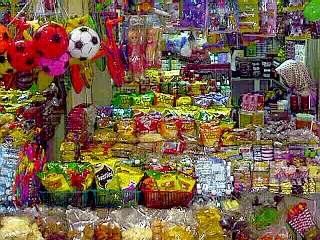 One
day I took a very long walk around the city. The hardest part was that it was
HOT, but I just brought along two extra t-shirts (and I used them!). I passed
many stands like this one, selling every kind of snack you could imagine and
then some.
One
day I took a very long walk around the city. The hardest part was that it was
HOT, but I just brought along two extra t-shirts (and I used them!). I passed
many stands like this one, selling every kind of snack you could imagine and
then some.
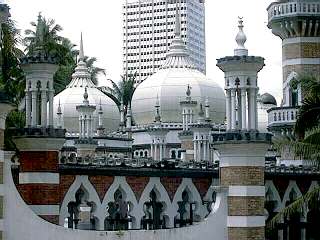 Near
the center of town I came upon one of the most famous sights in the city, Masjid
Jamek. (Masjid is the Malay word for "mosque".) Malays are devoutly Muslim,
though they still practice some behaviors that show their ancestors were animists
(like setting up spirit houses outside the main house, which some Malays still
do -- I'll add a photo from my 35-mm collection when I get home). Islam came
to Malaysia from southern India in the 14th century, successfully replacing
Hinduism as the area's major religion.
Near
the center of town I came upon one of the most famous sights in the city, Masjid
Jamek. (Masjid is the Malay word for "mosque".) Malays are devoutly Muslim,
though they still practice some behaviors that show their ancestors were animists
(like setting up spirit houses outside the main house, which some Malays still
do -- I'll add a photo from my 35-mm collection when I get home). Islam came
to Malaysia from southern India in the 14th century, successfully replacing
Hinduism as the area's major religion.
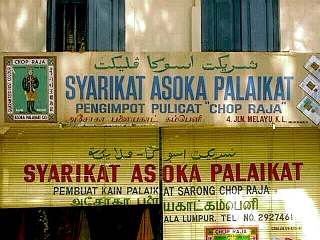 More
evidence of the country's Islamic faith: this sign is written in Jawi,
which is the Malay language written in Arabic letters. This form is usually
used for written teachings about Islam, but you can also see it around the country
on signs like this. It's interesting to note that the Malay language used to
be the "lingua franca" (common language) among traders in all the islands of
Southeast Asia (it's the "parent" of modern Indonesian, for example). Today,
you'd have to say that about English in Malaysia, as in much of the rest of
the world; here, that's due in great part to the fact that Malaysia was an English
colony. Many Malays are very proud of their language, though, and part of their
intensity in throwing off the binds of colonialism went into making Malay the
national language (which wasn't a "given", with so many Chinese and Indian Malaysians).
I have a favorite word in Malay, matahari, and I'll give you a hint what
it means."Mata" means "eye" and "hari" means "day", so it is
literally "eye of the day". Can you guess what the word "matahari" would
mean? (A: "sun." Get it -- "eye of the day?")
More
evidence of the country's Islamic faith: this sign is written in Jawi,
which is the Malay language written in Arabic letters. This form is usually
used for written teachings about Islam, but you can also see it around the country
on signs like this. It's interesting to note that the Malay language used to
be the "lingua franca" (common language) among traders in all the islands of
Southeast Asia (it's the "parent" of modern Indonesian, for example). Today,
you'd have to say that about English in Malaysia, as in much of the rest of
the world; here, that's due in great part to the fact that Malaysia was an English
colony. Many Malays are very proud of their language, though, and part of their
intensity in throwing off the binds of colonialism went into making Malay the
national language (which wasn't a "given", with so many Chinese and Indian Malaysians).
I have a favorite word in Malay, matahari, and I'll give you a hint what
it means."Mata" means "eye" and "hari" means "day", so it is
literally "eye of the day". Can you guess what the word "matahari" would
mean? (A: "sun." Get it -- "eye of the day?")
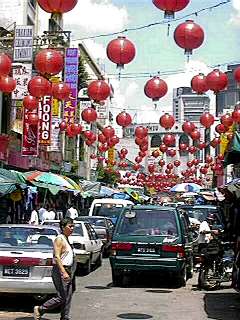 As
I've said, despite Islam being the most common faith and the national religion,
other religions are not only tolerated but even celebrated. When I got to Chinatown,
I found the streets crowded with people preparing to join in the festivities
around the Chinese New Year. This is Jalan Petaling, the main street in Chinatown,
where the decorations were the prettiest. (The red lanterns symbolize prosperity
for the coming year.) I think it's amazing that you'd find such a center of
Chinese culture, with its worship of many gods and idols and love of eating
pork, right next to a major mosque representing a religion that forbids all
those practices. That's a great example of what I mean when I say that Malaysia
is a "successful" multicultural society.
As
I've said, despite Islam being the most common faith and the national religion,
other religions are not only tolerated but even celebrated. When I got to Chinatown,
I found the streets crowded with people preparing to join in the festivities
around the Chinese New Year. This is Jalan Petaling, the main street in Chinatown,
where the decorations were the prettiest. (The red lanterns symbolize prosperity
for the coming year.) I think it's amazing that you'd find such a center of
Chinese culture, with its worship of many gods and idols and love of eating
pork, right next to a major mosque representing a religion that forbids all
those practices. That's a great example of what I mean when I say that Malaysia
is a "successful" multicultural society.
Thaipusam
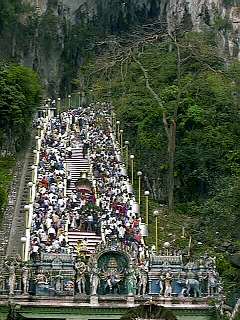 But
seeing all that didn't come CLOSE to preparing me for what I saw the next day.
This is the Hindu festival of Thaipusam. Each year, nearly a million Hindu devotees
from all over Malaysia come to the Batu Caves outside Kuala Lumpur to honor
Lord Muruga. Starting at Sri Mahamariaman Temple in KL, thousands of these followers
walk with this chariot all the way to these caves, thirteen kilometers (eight
miles) away, then up the 272 steps (shown here) into the main shrine.
But
seeing all that didn't come CLOSE to preparing me for what I saw the next day.
This is the Hindu festival of Thaipusam. Each year, nearly a million Hindu devotees
from all over Malaysia come to the Batu Caves outside Kuala Lumpur to honor
Lord Muruga. Starting at Sri Mahamariaman Temple in KL, thousands of these followers
walk with this chariot all the way to these caves, thirteen kilometers (eight
miles) away, then up the 272 steps (shown here) into the main shrine.
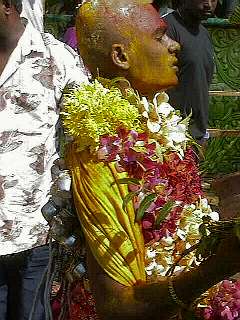 The
penitents (worshippers asking for forgiveness) come to apologize to Lord
Muruga for their sins. The focus of this penitence is an act of kavadi,
which is a contribution to Muruga. This contribution can come in the form of
shaving off one's hair and wearing flowers...
The
penitents (worshippers asking for forgiveness) come to apologize to Lord
Muruga for their sins. The focus of this penitence is an act of kavadi,
which is a contribution to Muruga. This contribution can come in the form of
shaving off one's hair and wearing flowers...
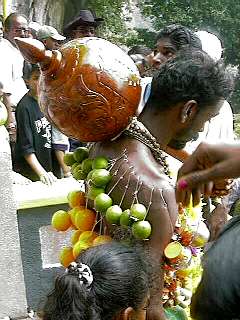 ...but
most go much farther, performing acts of self-mutilation to show their apologies
and gain favor with the gods. They pierce their skin with spikes, often attaching
heavy fruits or small pots of milk to add to the pain. Some pierce their tongues
and cheeks, too, with trident-shaped skewers. The really devout, though...
...but
most go much farther, performing acts of self-mutilation to show their apologies
and gain favor with the gods. They pierce their skin with spikes, often attaching
heavy fruits or small pots of milk to add to the pain. Some pierce their tongues
and cheeks, too, with trident-shaped skewers. The really devout, though...
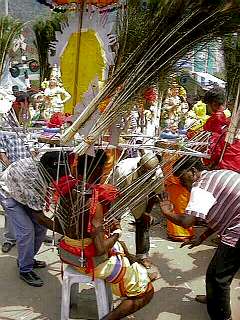 ...wear
circular frames decorated with peacock feathers, flowers and pictures of gods,
which they attach to their backs and chests with hooked chains. It's hard to
believe the exertion they expend walking eight miles carrying these frames (which
can weigh over 100 pounds), with hooks through their skin, in excruciating heat
-- I almost collapsed just watching them!
...wear
circular frames decorated with peacock feathers, flowers and pictures of gods,
which they attach to their backs and chests with hooked chains. It's hard to
believe the exertion they expend walking eight miles carrying these frames (which
can weigh over 100 pounds), with hooks through their skin, in excruciating heat
-- I almost collapsed just watching them!
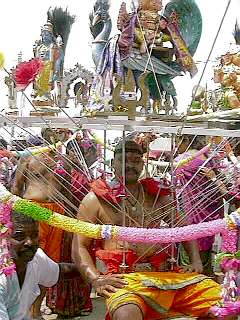 And
they keep coming, and coming, and coming...one after another, a constant procession
of hundreds if not thousands in all over the three days of the festival, each
almost like a Carnaval float because they have a full contingent of family and
friends who beat drums, dance around them and chant "Vel! Vel!" as they make
their way to the cave shrine.
And
they keep coming, and coming, and coming...one after another, a constant procession
of hundreds if not thousands in all over the three days of the festival, each
almost like a Carnaval float because they have a full contingent of family and
friends who beat drums, dance around them and chant "Vel! Vel!" as they make
their way to the cave shrine.
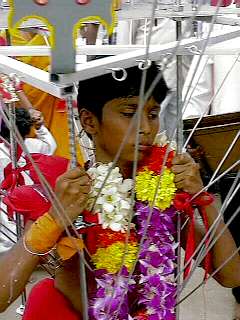 Many
if not all are in a trance throughout the ordeal, like this young man (who we
heard was twelve). Such trance lets you do incredible things: he'd dance around
frantically in wild circles for about a minute, moving forward about twenty
feet in the process...
Many
if not all are in a trance throughout the ordeal, like this young man (who we
heard was twelve). Such trance lets you do incredible things: he'd dance around
frantically in wild circles for about a minute, moving forward about twenty
feet in the process...
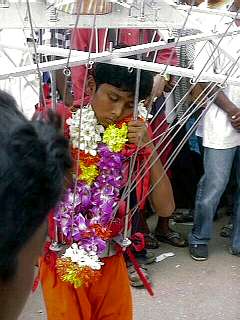 ...then
collapse onto a chair, with his family coming around to support him and massage
his legs. A couple of minutes later, he'd suddenly spring up again for another
minute of heated dance. Simply amazing.
...then
collapse onto a chair, with his family coming around to support him and massage
his legs. A couple of minutes later, he'd suddenly spring up again for another
minute of heated dance. Simply amazing.
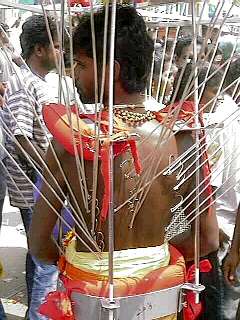 This
form of penitence with self-mutilation is a local variation, I was told, and
not to be found outside Malaysia and Singapore. I've certainly never heard of
it anywhere else, though the idea of making a self-sacrifice to atone for sins
is common. And, it should be said, others on the scene were doing other things
to make the event special: one group, for example, contributed enough food to
feed thirteen thousand people for free!
This
form of penitence with self-mutilation is a local variation, I was told, and
not to be found outside Malaysia and Singapore. I've certainly never heard of
it anywhere else, though the idea of making a self-sacrifice to atone for sins
is common. And, it should be said, others on the scene were doing other things
to make the event special: one group, for example, contributed enough food to
feed thirteen thousand people for free!
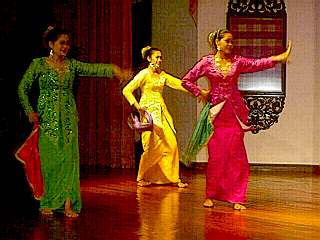 Coming
back from Thaipusam, I wasn't sure I could find anything to keep me interested
(it was pretty amazing, don't you think?) But I figured there was still lots
to see, and I set out to find it. Not far from my hotel, I came across a center
where this performance of traditional Malay dance was going on. Like many forms
of Malay dance, it was originally performed in royal courts. Once there were
no longer kings, the dances became part of the country's folk tradition. Malay
dance, like that in Indonesia, often portrays episodes from the Hindu epic the
Ramayana. This is also true of wayang kulit, shadow puppetry,
which also has much in common with that art form as done in Indonesia.
Coming
back from Thaipusam, I wasn't sure I could find anything to keep me interested
(it was pretty amazing, don't you think?) But I figured there was still lots
to see, and I set out to find it. Not far from my hotel, I came across a center
where this performance of traditional Malay dance was going on. Like many forms
of Malay dance, it was originally performed in royal courts. Once there were
no longer kings, the dances became part of the country's folk tradition. Malay
dance, like that in Indonesia, often portrays episodes from the Hindu epic the
Ramayana. This is also true of wayang kulit, shadow puppetry,
which also has much in common with that art form as done in Indonesia.
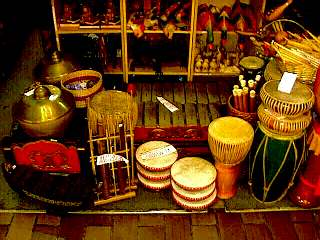 At
the Central Market, I found this store selling traditional Malay musical instruments.
These are also very similar to Indonesian instruments; in both, the music is
mostly percussion with a stringed instrument and perhaps a flute or two to complement
a full orchestra of drums, chimes, gongs and xylophones.
At
the Central Market, I found this store selling traditional Malay musical instruments.
These are also very similar to Indonesian instruments; in both, the music is
mostly percussion with a stringed instrument and perhaps a flute or two to complement
a full orchestra of drums, chimes, gongs and xylophones.
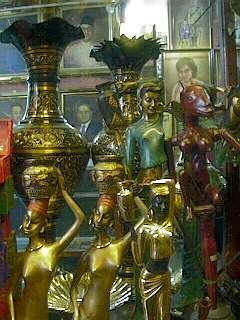 Malay
crafts focus on two fields: metal work and weaving. This photo shows some beautiful
silver and bronze pieces done by Malay craftspeople...
Malay
crafts focus on two fields: metal work and weaving. This photo shows some beautiful
silver and bronze pieces done by Malay craftspeople...
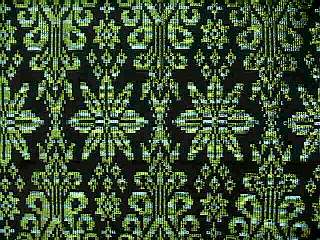 ...and
this is an example of songket weaving, considered to be the most complex
and beautiful textile work done in the country. Malaysians also do wonderful
batiks, which you might have seen on the Indonesia site, too. (I said I'd
give them a plug for letting me take this photo, so: This weaving comes from
Songket Sutera Asli, Central Market, Kuala Lumpur.)
...and
this is an example of songket weaving, considered to be the most complex
and beautiful textile work done in the country. Malaysians also do wonderful
batiks, which you might have seen on the Indonesia site, too. (I said I'd
give them a plug for letting me take this photo, so: This weaving comes from
Songket Sutera Asli, Central Market, Kuala Lumpur.)
 Of
course, many Malaysians are happy to get their entertainment from another art
form, cinema. Some movies, like the one advertised in this poster, are made
inside the country, but most seen in Malaysian theaters are from outside and
are shown with Malay subtitles (even though many Malaysians are fluent in English
and can understand English-language films without them). The ones inside the
country are heavily influenced by Indian cinema -- bet you didn't know that
India makes more films than any other country in the world (even the U.S.)!
Of
course, many Malaysians are happy to get their entertainment from another art
form, cinema. Some movies, like the one advertised in this poster, are made
inside the country, but most seen in Malaysian theaters are from outside and
are shown with Malay subtitles (even though many Malaysians are fluent in English
and can understand English-language films without them). The ones inside the
country are heavily influenced by Indian cinema -- bet you didn't know that
India makes more films than any other country in the world (even the U.S.)! 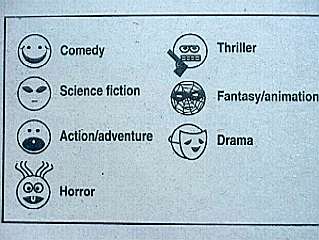 Speaking
of movies, I just included this photo because I think it shows a cute way of
classifying them. (It was in the major English-language newspaper in Kuala Lumpur.)
Speaking
of movies, I just included this photo because I think it shows a cute way of
classifying them. (It was in the major English-language newspaper in Kuala Lumpur.)
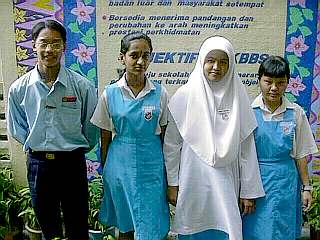 On
my last day in Kuala Lumpur, I visited Sekolah Menenga Kebangsaan Banda Baru
Sentul (SMKBBS, or BBS High School, for short). This is the first school
I visited that reminded me of my school in San Francisco, though it's distinctly
Malaysian. Here you see four students at the school: Alex, who's Malay; Gayathri,
who's Indian; Maisara, who's Malay; and Ho, who's Chinese. As you can see, they
wear uniforms, as has been true of every school I've visited so far in Southeast
Asia. The sign behind them tells the mission of the school. (Anticipating questions:
Maisara's outfit is called a baju kurung, and her head covering is called
a tudong; the dot on Gayathri's forehead is called a pottu. If
you want to know more, you'll have to ask them -- see below!)
On
my last day in Kuala Lumpur, I visited Sekolah Menenga Kebangsaan Banda Baru
Sentul (SMKBBS, or BBS High School, for short). This is the first school
I visited that reminded me of my school in San Francisco, though it's distinctly
Malaysian. Here you see four students at the school: Alex, who's Malay; Gayathri,
who's Indian; Maisara, who's Malay; and Ho, who's Chinese. As you can see, they
wear uniforms, as has been true of every school I've visited so far in Southeast
Asia. The sign behind them tells the mission of the school. (Anticipating questions:
Maisara's outfit is called a baju kurung, and her head covering is called
a tudong; the dot on Gayathri's forehead is called a pottu. If
you want to know more, you'll have to ask them -- see below!)
 This
sign expresses why the school seems so "familiar" to me. It shows the numbers
of bumiputra (Malay), Chinese and Indian students enrolled in the school. While
the school has a majority of Malay students, it also has good numbers of Chinese
and Indian students, reminding me of the multicultural nature of my own school
(which has six ethnic groups that comprise over five percent of the school population,
with none making up over forty percent). It is a public school, and draws students
from the local community. Many students are from low-income families, many of
which are single-parent or have problems holding together.
This
sign expresses why the school seems so "familiar" to me. It shows the numbers
of bumiputra (Malay), Chinese and Indian students enrolled in the school. While
the school has a majority of Malay students, it also has good numbers of Chinese
and Indian students, reminding me of the multicultural nature of my own school
(which has six ethnic groups that comprise over five percent of the school population,
with none making up over forty percent). It is a public school, and draws students
from the local community. Many students are from low-income families, many of
which are single-parent or have problems holding together.
| I asked a friend of mine in Kuala Lumpur why she thought there was a general feeling of racial harmony in Malaysia. She pointed to the schools. "Everyone must learn to speak Malay," she said, "but core classes do not have to be in Malay. For example, there are Chinese-language schools and Hindi-language schools where the core classes are in those languages, and students take Malay as a separate required class. Many Malay students attend those schools, too! And, they do get equal funding from the government to all schools." If only California had such an enlightened approach. |
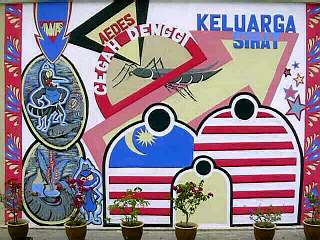 Around
the school, there are several murals like this one (which warns viewers about
the dangers of dengue fever, a common mosquito-transmitted disease in
the tropics that lays you up with severe muscle aches and nausea for weeks).
The arts are a focus here: there is a wood shop and several other arts-related
classes. The students identified this as one of the strengths of the school,
along with the way it develops their leadership skills. Alex, for example, is
a "prefect": he's chosen by other students to help the teacher with maintaining
discipline (including, for example, dealing with conflicts). I asked Alex if
this put him in the position of being thought of as a "teacher's pet", but he
seemed to feel not (though he smiled at the question) -- for one, he was chosen
by the students, and for another discipline was not a big issue at the school,
in his eyes, because of a general respect for teachers. (I had to throw that
one in.)
Around
the school, there are several murals like this one (which warns viewers about
the dangers of dengue fever, a common mosquito-transmitted disease in
the tropics that lays you up with severe muscle aches and nausea for weeks).
The arts are a focus here: there is a wood shop and several other arts-related
classes. The students identified this as one of the strengths of the school,
along with the way it develops their leadership skills. Alex, for example, is
a "prefect": he's chosen by other students to help the teacher with maintaining
discipline (including, for example, dealing with conflicts). I asked Alex if
this put him in the position of being thought of as a "teacher's pet", but he
seemed to feel not (though he smiled at the question) -- for one, he was chosen
by the students, and for another discipline was not a big issue at the school,
in his eyes, because of a general respect for teachers. (I had to throw that
one in.)
 Here
is a sign at the school, again showing the role that English plays in Malaysia.
Knowing English today is perceived as a key to success in an international world,
so even if it is viewed as having tinges of "economic colonialism" attached
to it, people also feel it's important to learn it.
Here
is a sign at the school, again showing the role that English plays in Malaysia.
Knowing English today is perceived as a key to success in an international world,
so even if it is viewed as having tinges of "economic colonialism" attached
to it, people also feel it's important to learn it.The students at SMKBBS really want to communicate with students in the U.S. -- they speak English, too! (And many speak Chinese, if that's your preference...) If you would like to write to students at SMKBBS, please e-mail me.